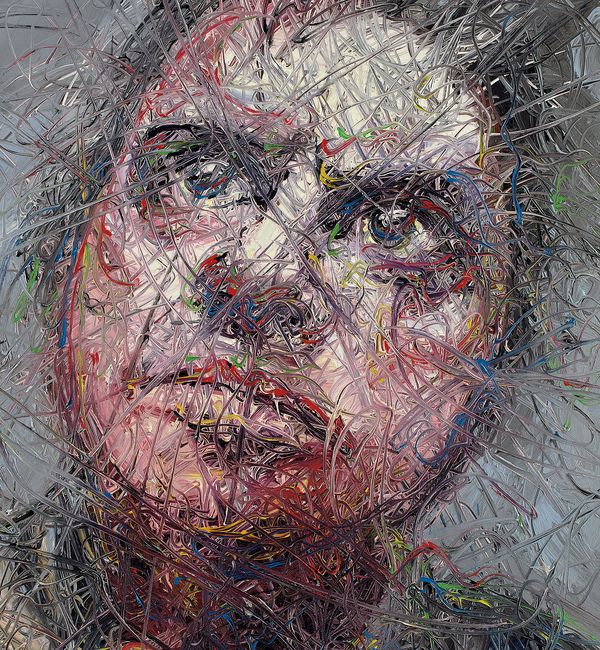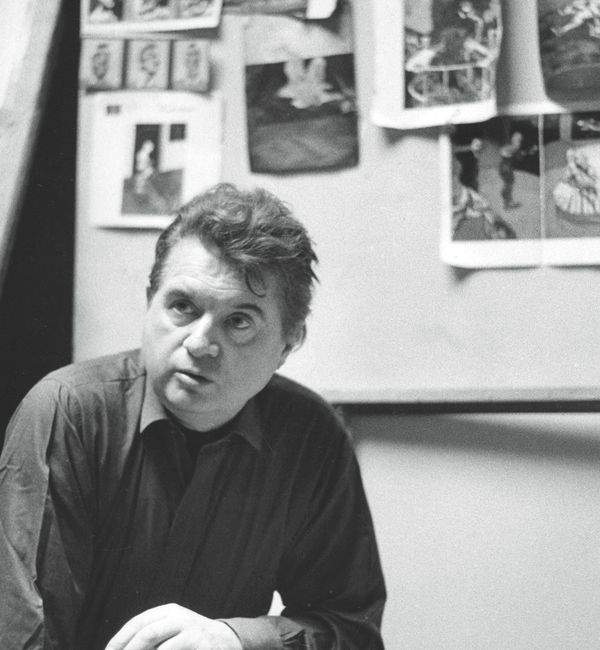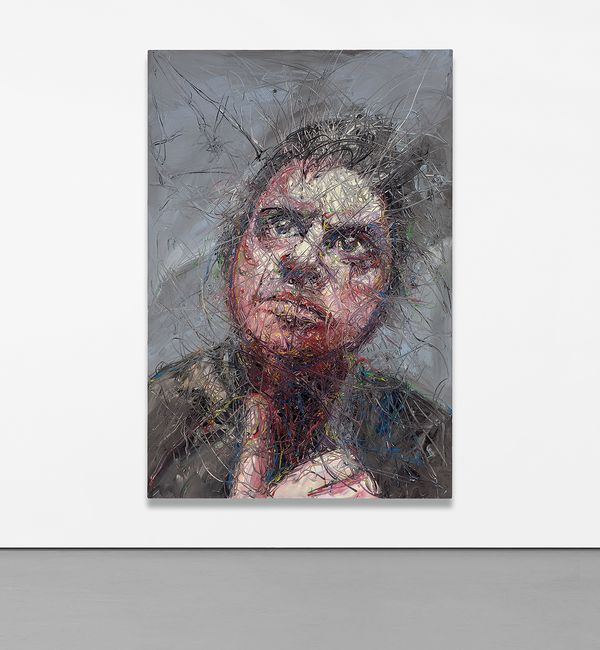Detail from Zeng Fanzhi's Untitled (Bacon), 2005
Untitled (Bacon), 2005, is an important and emotive example from Zeng Fanzhi ’s Portraiture series, created at a time when the artist was searching for a way to systematically ‘unmask’ his subjects and seek an increasingly direct expressionistic language. Having always been enthralled by the opportunities presented by portraiture, Zeng has continually reinvented and reinvigorated the subject throughout his career. Best-known for his Mask series, which focused on capturing the contradiction between the external pomposity and inner emptiness of the inhabitants of cosmopolitan Beijing, after 2000, Zeng began to unmask his canvases’ protagonists. The artist’s penchant for transforming appearances evolved from a simple concealment of his subjects’ faces to a more complex, and intensely psychological warping, all the while remaining entirely faithful to his own artistic identity. These contortions pay homage to those of Francis Bacon’s own paintings, presenting a counter-point of intense and raw emotional vulnerability to the earlier works. In this way, Untitled (Bacon) forms a perfect corollary and is a natural heir to the Masks.
Francis Bacon in his studio, London, 1966. Artwork © The Estate of Francis Bacon. Image: Photo © Mario Dondero / Bridgeman Images
Zeng studied the Western art historical canon and the Occidental philosophical tradition alongside his explorations of the art of his native culture. Max Beckmann, Willem de Kooning, Lucian Freud and Francis Bacon – the latter forming the subject the present work – inspired Zeng to find an individual voice from within the rote pedagogy of Soviet Socialist Realism that then guided the curriculum. Taking Andy Warhol, Mao, Lucian Freud and Marilyn Monroe amongst others as his subjects, Zeng evolved an idiosyncratic style that suffuses a pantheon of references across both Eastern and Western traditions. Zeng crossed the Rubicon, daring to turn his back on Socialist Realism in a newly capitalist China. His aesthetic restlessness is the paradigmatic expression of the evolution of Chinese contemporary art post-1989.
Installation view of Zeng Fanzhi's Untitled (Bacon), 2005
The vast scale of the canvas combined with the energetic brush marks is a fitting tribute to its subject matter, a titan of 20th-century modernism. Bacon’s psychic portraits unquestionably altered the status of the human figure in the 1900s. Densely-knotted calligraphic tangles of paint construct Bacon’s physiognomy, simultaneously creating and distorting the subject’s facial features, which, coupled with the subject’s thoughtful facial expression, lends the figure a paradoxically introspective dynamism. Commenting on the two artists’ styles, Yuko Hasegawa writes, "in most of Bacon’s work, the faces covered with these obliterating brush strokes have wide-open, crying mouths. They represent a hysterical state of mind; a raw, almost tangible, fear. Zeng’s tarnished faces, conversely, represent the figures’ quiet skepticism and awe" (Yuko Hasegawa, 'Painting as Speculative Realism', Zeng Fanzhi: Paintings, Drawings, and Two Sculptures). Zeng himself describes Bacon’s work as 'hugely influential' to him as a young artist alongside those of Bacon’s close friend, Freud (Phong Bui, 'Interview with Zeng Fanzhi', The Brooklyn Rail). Indeed, Zeng’s portrait of Bacon has much in common with Freud’s famous rendering of his friend. Untitled (Bacon) forms part of a series of portraits by the artist celebrating cultural icons including Freud, completing the network of homages to each other paid by the artists.
Zeng’s secret of striking an emotional cord with viewers lies in his ability to liberate us from the rigid framework of culture-specific iconography. — Chiu-Ti Jansen, 'Unmasking Icons: Zeng Fanzhi’s Retrospective in Paris'
Typical of Zeng’s post-millennial works, the complex weave of brushstrokes in Untitled (Bacon) are created with intense physical involvement; using his entire body to stretch across the breadth of the canvas, Zeng uses his virtuosic ability to handle multiple paintbrushes at once, creating an impressive symbiosis of thick impasto and delicate, lacelike lines. Remarking on this process, Zeng has stated: "I have to paint very fast and almost without thinking. […] when your technique reaches a certain level, you’re freed from yourself. You’re already certain and accurate without knowing it. I don’t have to look with my eyes to get my soul, body, and the canvas to reach a state of unity. It’s the highest form of freedom" (Phong Bui, 'Interview with Zeng Fanzhi'). Zeng’s sophisticated underlying pictorial grammar recalls Jackson Pollock’s lauded drip paintings and the psychic automatism of the Surrealists. In venturing into abstraction, Zeng also reacquainted himself with traditional Chinese ink painting particularly from the Northern Wei to Song and Yuan dynasties from the 14th and 15th centuries, adding to the multifaceted wealth of Eastern and Western influences. It is an extension of the consistent challenge to the boundary between Eastern and Western artmaking that Zeng’s praxis epitomizes; mingling the history of China with his own personal history, the artist effortlessly combines the macrocosmic view with his individual microcosms.


